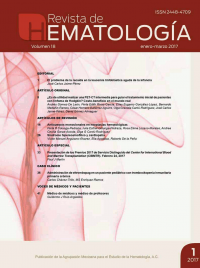Rev Hematol Mex. 2017 ene;18(1):5-15.
Gómez-De León A, Rivas-García PE, González-López EE, Medellín-Ramos B, Gutiérrez-Aguirre CH, Cantú-Rodríguez OG, Jaime-Pérez JC, Gómez-Almaguer D
Servicio de Hematología, Departamento de Medicina Interna, Facultad de Medicina y Hospital Universitario Dr. José Eleuterio González, Universidad Autónoma de Nuevo León.
Resumen
OBJETIVO: evaluar el costo-beneficio de la tomografía por emisión de positrones-tomografía computada intermedia (PET-CTi) posterior al segundo o tercer ciclo de ABVD en linfoma de Hodgkin como modelo para aplicar en México y otros países en desarrollo.
MATERIAL Y MÉTODO: estudio ambispectivo en el que se incluyeron pacientes con linfoma de Hodgkin, quienes posterior al segundo o tercer ciclo de ABVD se estudiaron mediante PET-CTi.
RESULTADOS: 20 pacientes se siguieron durante 25 meses. Al diagnóstico, el estadio Ann Arbor fue I-II en 70% de los casos, 35% manifestó síntomas B y un paciente tuvo masa bulky mediastinal. En 16 casos la PET-CTi fue negativa y en 4 fue positiva. Al final del tratamiento, los 16 pacientes con PET-CTi negativa continuaron en remisión completa, uno recayó posteriormente. Dos de cuatro pacientes con PET-CTi positivas tuvieron remisión completa, uno recayó posteriormente y los otros dos progresaron. La supervivencia libre de progresión de los pacientes con resultado negativo y positivo fue de 94 y 25%, respectivamente.
CONCLUSIONES: la PET-CTi permite predecir el pronóstico en cualquier estadio clínico. Nuestro análisis de costo-beneficio sugiere que es factible realizar una PET-CTi antes del cuarto ciclo de quimioterapia, a pesar de su costo elevado, ya que a la larga los costos se igualan. Esta estrategia es prometedora y debe reproducirse en nuestro país y en otros países en desarrollo.
PALABRAS CLAVE: linfoma de Hodgkin, PET-CT intermedia, costo-beneficio, ABVD.
Is it useful to perform an interim PET-CT to guide the initial treatment of patients with Hodgkin’s lymphoma? Cost-benefit in the real world.
Rev Hematol Mex. 2017 Jan;18(1):5-15.
Gómez-De León A, Rivas-García PE, González-López EE, Medellín-Ramos B, Gutiérrez-Aguirre CH, Cantú-Rodríguez OG, Jaime-Pérez JC, Gómez-Almaguer D
Servicio de Hematología, Departamento de Medicina Interna, Facultad de Medicina y Hospital Universitario Dr. José Eleuterio González, Universidad Autónoma de Nuevo León.
Abstract
OBJECTIVE: To evaluate the cost-effectiveness of performing an interim PET-CT (PET-CTi) after cycles 2-3 of ABVD in patients with Hodgkin’s lymphoma, as a model for application in Mexico and other developing countries.
MATERIAL AND METHOD: An ambispective study was done including patients with Hodgkin’s lymphoma who underwent PET-CTi.
RESULTS: A total of 20 patients were followed for 25 months. At diag-nosis, Ann Arbor stage was I-II in 70%. Sixteen PET-CTi scans were negative and in complete remission; 4/20 were positive. At the end of treatment, patients with a negative PET-CTi were still in complete remission, one relapsed later. Two of the four PET-CTi-positive patients were in complete remission; one relapsed later, while the remainder had progressive disease. The progression-free survival of patients with negative and positive PET-CT was 94% and 25%, respectively.
CONCLUSIONS: PET-CTi is able to predict prognosis in any clinical stage. Our cost-effectiveness analysis suggests that it is feasible to perform an interim PET-CTi before the fourth cycle of ABVD despite its high cost, as eventually costs will balance. This is a promising strategy, which should be reproduced in Mexico and other developing countries.
KEYWORDS: Hodgkin’s lymphoma; interim PET-CT; cost-effectiveness; ABVD

